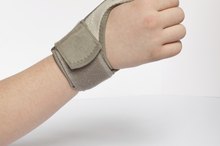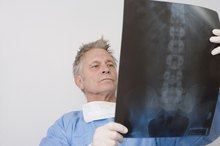What Kind of Back Brace Is Worn After Lumbar Back Surgery?
After back surgery, it is commonplace for a surgeon to recommend a brace to help keep your spine immobile while it is healing. Limiting motion aids in the healing process and may also decrease discomfort. Generally, braces are recommended based on the type of surgery performed and how much motion your physician wishes to limit. Braces come in two main styles: hard or rigid, and soft.
TLSO
TLSO, or thoraco-lumbar sacral orthosis braces, are the most common back braces prescribed after surgery 1. This brace is rigid, and is composed of two form-fitted plastic shells that are held together with straps. These braces are also commonly referred to as "clam-shell braces." Generally, these braces are custom fit for each individual patient. TLSO braces can limit up to 50 percent of the spine's movement. Unfortunately, patients may find these braces to be uncomfortable or hot.
- TLSO, or thoraco-lumbar sacral orthosis braces, are the most common back braces prescribed after surgery 1.
- TLSO braces can limit up to 50 percent of the spine's movement.
LSO
Types of Back Braces for Compression Fractures
Learn More
LSO, or lumbo-sacral orthosis braces, are also rigid custom form-fitted braces. These braces are smaller in size when compared to the TLSO. Due to their smaller size, these braces do not limit as much motion as the TLSO. These braces are best for limiting motion between the lumbar and sacral portions of the spine. This brace may be used if your surgery is on your lower lumbar segments, whereas a TLSO is used for higher lumbar segments.
- LSO, or lumbo-sacral orthosis braces, are also rigid custom form-fitted braces.
- This brace may be used if your surgery is on your lower lumbar segments, whereas a TLSO is used for higher lumbar segments.
Quick Draw Braces
Quick draw style braces are soft in nature. These braces are made of fabric and elastic and generally have some type of rigid stability built in. These braces are easy to fasten and remove with Velcro-style straps. Although these braces do not limit as much motion as their rigid counterparts, they do provide stability and support for the lumbar spine after injury or surgery. These braces generally come off-the-shelf, meaning they do not need to be custom fabricated.
- Quick draw style braces are soft in nature.
- These braces are made of fabric and elastic and generally have some type of rigid stability built in.
Abdominal Binder
How to Fix a Herniated Disk in the Neck
Learn More
Abdominal binders are also soft braces that may be worn after surgery. These braces generally consist of elastic fabric that wraps around the midsection of the user. These braces provide compression with limited stability and support, and may help some patients breathe better after surgery. Abdominal binders are often used in conjunction underneath a TLSO. Compared to TLSOs, these braces are relatively inexpensive and are available off-the-shelf.
- Abdominal binders are also soft braces that may be worn after surgery.
- Abdominal binders are often used in conjunction underneath a TLSO.
Lifting Belts
Lifting belts may be used after the initial bracing period is over, or even before having back surgery. These belts provide limited stability and support for the lower back, and are generally work during work activities such as lifting. These braces can help reduce low back strain and muscle fatigue that occurs with prolonged activity 1. These braces are usually made of cloth or canvas and may or may not have sewn in support, they are available off the shelf.
- Lifting belts may be used after the initial bracing period is over, or even before having back surgery.
- These belts provide limited stability and support for the lower back, and are generally work during work activities such as lifting.
Related Articles
References
Writer Bio
Tyler Shultz is a third-year doctor of physical therapy student at the Medical College of Georgia in Augusta, Ga. His articles have appeared in numerous physical therapy blogs since 2009, including PT ThinkTank and AAOMPT-sSIG blog. Tyler graduated from the University of Georgia with a Bachelor of Science in health promotion in 2007.









